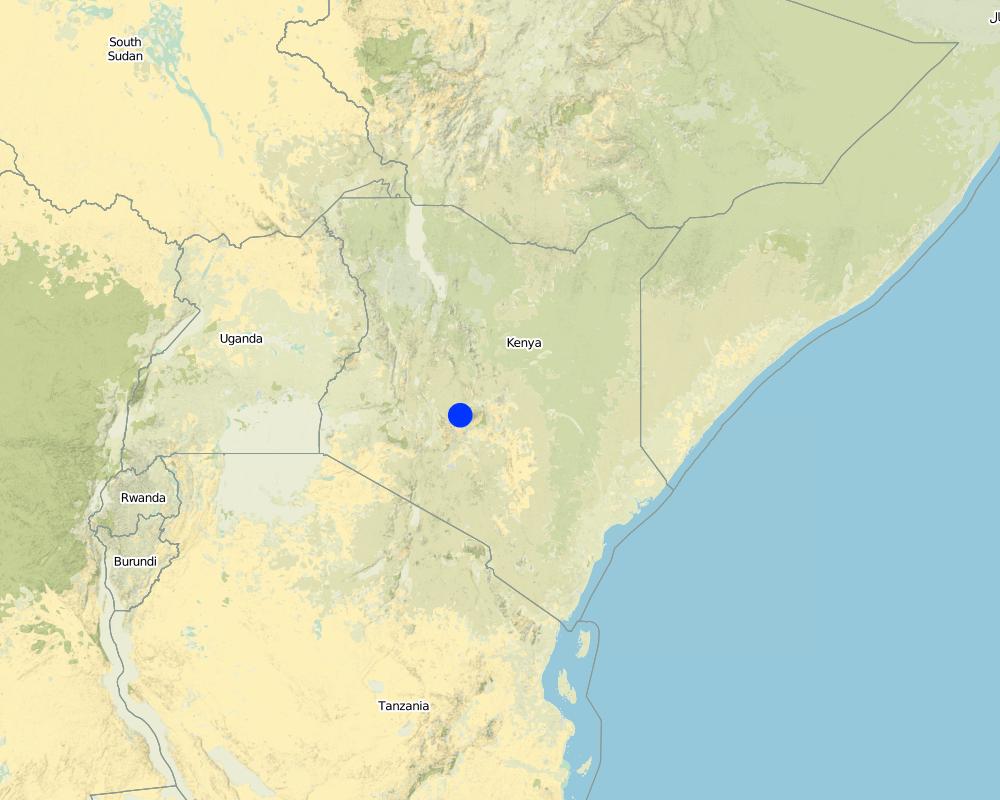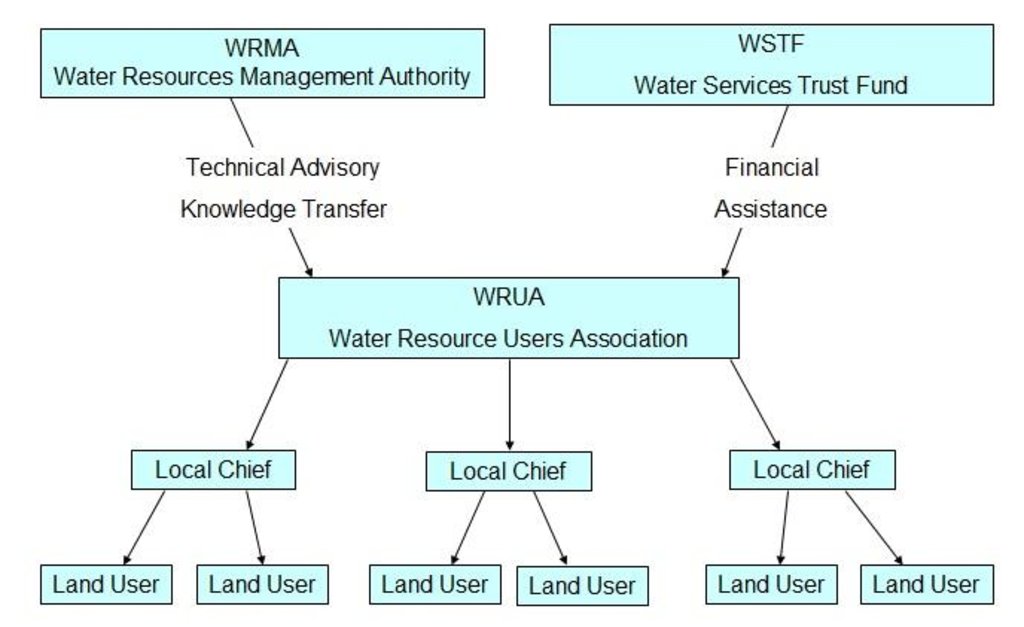Water Resource Users Association for the management of water resources in a river sub-catchment. [肯尼亚]
- 创建:
- 更新:
- 编制者: Manuel Fischer
- 编辑者: –
- 审查者: Fabian Ottiger
approaches_2477 - 肯尼亚
查看章节
全部展开 全部收起1. 一般信息
1.2 参与方法评估和文件编制的资源人员和机构的联系方式
SLM专业人员:
Ndung'u Martin
0735-789-423
WRUA Naro Moru
Naro Moru, P.O box 32-10105 Naro Moru
肯尼亚
有助于对方法进行记录/评估的机构名称(如相关)
University of Bern, Institute of Geography (GIUB) - 瑞士有助于对方法进行记录/评估的机构名称(如相关)
Water Resource Use Association Naro Moru (WRUA Naro Moru) - 肯尼亚1.3 关于使用通过WOCAT记录的数据的条件
编制者和关键资源人员接受有关使用通过WOCAT记录数据的条件。:
是
2. SLM方法的描述
2.1 该方法的简要说明
WRUA are associations of water users and riparian land owners who have associated for the purposes of cooperatively sharing, managing and conserving a common water resource.
2.2 该方法的详细说明
该方法的详细说明:
Aims / objectives: The overall objective is to facilitate everybody in the river sub-catchment with sufficient and good quality water supply even during dry spells. Further objectives are to conserve the water catchment, to manage the resources properly, to preserve riverine forests and the riparian ecosystem, stop pollution and establish water use rules that are broadly accepted.
Methods: The WRUA is an association of stakeholders who wants to achieve the objectives mentioned above. During the regular meetings each stakeholder can raise his voice, express his needs and vote in a democratic manner. For outsiders and the government it is also an official contact in terms of water resources. The WRUA members arrive at a decision together and thus lead to direct democratic and sustainable development. Together, they accomplish the activities mentioned below.
Stages of implementation: First, a WRUA needs to register at the regional WRMA (Water Resources Management Authority) office, this ensures legal security for the WRUA. The WRMA provides the WRUA with technical and administrative advisory and is part of the Ministry of Water and Irrigation. The members of the WRUA conduct a water abstraction survey in the sub-catchment to identify all legal and illegal water abstractions. It is crucial to know the accurate water flows before you can conserve the water resources. The goal is to convince illegal abstractors to apply for a permit to legalise the abstractions. The WRUA
organises meetings, called barazzas, with the local chief and the riparian land users. In these meetings special conservation measures applied in the riparian area are discussed together with land management specialists. The conservation measures are cutting of water guzzling trees, planting of water-friendly indigenous trees, raise public awareness of pollution, rehabilitation of riverbanks and introduction of new technologies like drip
irrigation and rooftop water harvesting. To raise public awareness of the importance of the riparian area, the WRUA members conduct a pegging campaign along the main river of the sub-catchment. The water act 2002 dictates a riparian area of at least 6 metres on either side of the river. This area is being delineated to indicate the location of the protected to the land users. During water shortages (for example a dry spell), the WRUA publishes rules for water abstractions to ensure water supply for all land users.
Role of stakeholders: Furthermore, the WRUA is an important tool for stakeholders for communication and conflict management related to water resources. Due to the immense importance of water for ecosystem services a proper management of this resource is required.
2.5 采用该方法的国家/地区/地点
国家:
肯尼亚
区域/州/省:
Kenya/Central Province
有关地点的进一步说明:
Nyeri/Naro Moru
Map
×2.6 该方法的开始和终止日期
注明开始年份:
2002
2.7 方法的类型
- government
2.8 该方法的主要目的/目标
The Approach focused mainly on SLM with other activities
The objective of implementing a governmental promoted association was to counter the numerous conflicts that have
arisen around water resources. The water resources were distributed inequitably and the riparian ecosystem was
damaged. Therefore WRUAs were built to improve water quality and increase water quantity by implementing protective
measures in riparian zones, mediate conflicts concerning water, stop river pollution and establish water use rules.
The SLM Approach addressed the following problems: The WRUA was formed when some non-riparian water abstractors had no more water because the river was running dry.
Meanwhile also bad land use practices in the riparian zones of Kapingazi river diminished water quality. Due to forest
clearing close to the river, the soil lost its water storage capacity, even worse indigenous trees were replaced by water
guzzling trees like eucalyptus. The knowledge about conservation measures in the riparian areas was very low.
2.9 推动或妨碍实施本办法所适用的技术的条件
其他
- 阻碍
There are land users who do not want to implement the proposed technologies. Some land users do not agree with the ideas of the WRUA, others are just conservative and want to continue their old habits.
Treatment through the SLM Approach: Restless spreading of the ideas and reasons of the WRUA can maybe convince some land users.
3. 相关利益相关者的参与和角色
3.1 该方法涉及的利益相关者及其职责
- 当地土地使用者/当地社区
Especially riparian land users
All riparian users were adressed no matter what social or economical status they had. However it must be said that the riparian land users are among the more privileged ones, because they have direct access to water resources. In this sense, non-riparian land users were disadvantaged, because they could not profit of the seedling distribution. Non-riparian users were not target of the approach. The men/women ratio of the adressed land users depended strongly on the point in time the meetings were scheduled. At a morning meeting in a downstream area, 60% of the present land users were women. The reason is that many men were not available at this time, so the wife replaced them. In an upstream area, there were mostly men attendant.
In this region, the land ownership traditionally belongs to the man of the family. That is the reason why mostly men are adressed and participated at the barazza meetings. In case the husband is not available, the wife participates at the meeting.
- SLM专家/农业顾问
- 国家政府(规划者、决策者)
Water Resources Management Authority
3.2 当地土地使用者/当地社区参与该方法的不同阶段
| 当地土地使用者/当地社区的参与 | 指定参与人员并描述活动 | |
|---|---|---|
| 启动/动机 | 自我动员 | In the year 1999 Naro Moru river dried completely up for the first time. The consequence was a big clash between up- and downstreamers. The downstreamers located below Naro Moru town blamed the upstreamers and their irrigation systems for the low flows. The downstreamers walked upwards the river in search of water, eating food from the fields of upstreamers. This conflict made the formation of the association necessary involving all relevant water users. |
| 计划 | 外部支持 | The final measures were elaborated with support of the Water Resource Management Authority (WRMA). WRMA supported capacity building in terms of administrative knowledge and conservation technologies. |
| 实施 | 互动 | The implementation took place at barazzas with local chiefs. The associated riparian land users came together and were informed by the members of the WRUA and a land use specialist about the advantages of riparian protection. The different measures like tree planting and introduction of Napier were communicated. Water unfriendly trees like Eucalyptus were recommended to be cut. Also, the background of water quality and improved drought resistance were teached. Seedlings were distributed. |
| 监测/评估 | 自我动员 | The monitoring is done by the WRUA. Members walk regularly along the river and point out positive and negative examples. In case of negative examples, persuading of the land users is needed. |
| Research | 无 |
3.3 流程图(如可用)
具体说明:
The Chart shows how WRMA and WSTF support the WRUA with knowledge, technical advisory and financial assistance. The WRUA, composed of land users, is in contact with the land users via the chief.
作者:
Manuel Fischer
3.4 有关SLM技术选择的决策
具体说明谁有权决定选择要实施的技术:
- 主要是土地使用者,由SLM专家提供支持
解释:
The WRUA was thinking about measures that could be implemented and proposed them.
Decisions on the method of implementing the SLM Technology were made by WRUA. The members of the water resource users association mainly decided and implemented the measures for the protection of the riparian areas.
4. 技术支持、能力建设和知识管理
4.1 能力建设/培训
是否为土地使用者/其他利益相关者提供培训?:
是
培训形式:
- 农民对农民
- 示范区域
- 公开会议
涵盖的主题:
The most recent knowledge in riverbank protection and land conservation was communicated by the
WRMA to the WRUA and from the WRUA to the land users. Subjects treated are planting of waterfriendly indigenous
trees and chopping of water guzzling eucalyptus trees, as well as riverbank stabilization with trees and Napier grass. Pegging techniques were introduced to outline the riparian area. Furthermore, pollution prevention and new water-saving land use technologies were discussed.
4.2 咨询服务
土地使用者有权使用咨询服务吗?:
是
指明是否提供了咨询服务:
- 在土地使用者的土地上
说明/注释:
Name of method used for advisory service: Technical and institutional advisory; Key elements: Conservation advisory, Administrative advisory; The WRMA provides technical training for the WRUA members concerning planting of waterfriendly/water guzzling trees, riverbank stabilization with trees and Napier grass, pollution prevention, new water-saving land use technologies and also climate change issues that rose recently. The WRUA wrote also a sub-catchment management plan in cooperation with WRMA advisors.
Advisory service is very adequate to ensure the continuation of land conservation activities; Campaigns are being done as planned, but patrolling is not that profound.
4.3 机构强化(组织发展)
是否通过这种方法建立或加强了机构?:
- 是,适度
具体说明机构的强化或建立程度:
- 本地
- Seedling were bought locally
提供进一步细节:
The seedlings were bought from local community based organisations.
4.4 监测和评估
监测和评估是该方法的一部分吗?:
是
注释:
bio-physical aspects were None monitored by land users through observations; indicators: surviving trees were counted
There were several changes in the Approach as a result of monitoring and evaluation: It turned out that areas for the seedling distribution should be identified in a first step.
Also care taking of the seedlings is an important step to ensure the survival, since 25% of the seedlings died.
4 out of ten drip irrigation demonstration plots were relocated.
There were no changes in the Technology as a result of monitoring and evaluation
5. 融资和外部物质支持
5.1 该方法中SLM组成部分的年度预算
如果不知道准确的年度预算,请给出一个范围:
- 10,000-100,000
注释(例如主要的资助来源/主要捐助者):
Approach costs were met by the following donors: government (Water services trust fund): 57.0%; local government (district, county, municipality, village etc) (Laikipia Wildlife Forum): 43.0%
5.2 为土地使用者提供财政/物质支援
土地使用者是否获得实施该技术的财政/物质支持?:
是
如果是,请具体说明支持的类型、条件和提供者:
Got the seedlings
5.3 对特定投入的补贴(包括劳动力)
- 农业
| 具体说明哪些投入得到了补贴 | 程度如何 | 对补贴做出具体说明 |
|---|---|---|
| 种子 | 充分融资 | |
注释:
Land users got the seedlings and planted them by themselves.
5.4 信用
是否根据SLM活动的方法给予信用值?:
否
6. 影响分析和结论性陈述
6.1 方法的影响
该方法是否帮助土地使用者实施和维护SLM技术?:
- 否
- 是,很少
- 是,中等
- 是,支持力度很大
Water quality has been improved, riverine wildlife habitats have been enlarged, water storage capacity of the riparian zone has been ameliorated, vegetation cover and biodiversity have been increased.
该方法是否有助于社会和经济弱势群体?:
- 否
- 是,很少
- 是,中等
- 是,支持力度很大
Did other land users / projects adopt the Approach?
- 否
- 是,很少
- 是,中等
- 是,支持力度很大
Even land users who did not participate at the barazzas finally implement the proposed technologies, because they communicated with other land users.
Did the Approach lead to improved livelihoods / human well-being?
- 否
- 是,很少
- 是,中等
- 是,支持力度很大
Higher water quality is a direct output. In a long-term view, water availability will be bigger and riparian ecosystems will be able to regenerate.
Did the Approach help to alleviate poverty?
- 否
- 是,很少
- 是,中等
- 是,支持力度很大
6.2 土地使用者实施SLM的主要动机
- 支付/补贴
seedlings
- 规章制度(罚款)/执行
- law
water act was recited at the meetings
- current state of the riparian
makes farmers think about the future
6.3 方法活动的可持续性
土地使用者能否维持通过该方法实施的措施(无外部支持的情况下)?:
- 是
若是,请说明如何维持:
Under the condition that they keep applying the conservation measures. Public awareness raising and patrols by the WRUA have to continue.
6.4 该方法的长处/优点
| 土地使用者眼中的长处/优势/机会 |
|---|
| The meetings show a good turn up of people, this shows that they are needed. (How to sustain/ enhance this strength: Maybe even more land users can be motivated to show up at the meetings.) |
| A main advantage is that it is easy to communicate among the water stakeholders. (How to sustain/ enhance this strength: Regular meetings should be scheduled.) |
6.5 该方法的弱点/缺点以及克服它们的方法
| 土地使用者认为的弱点/缺点/风险 | 如何克服它们? |
|---|---|
| Not all riparian members are totally committed to the activities of the WRUA. | Try to persuade them to show more motivation. |
7. 参考和链接
7.1 方法/信息来源
- 实地考察、实地调查
- 与土地使用者的访谈
链接和模块
全部展开 全部收起链接
无链接
模块
无模块



